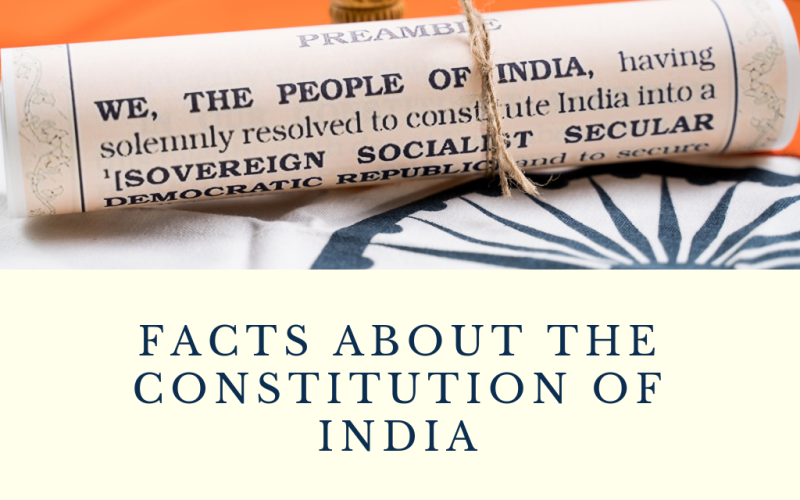Did you know that the constitution of India is the longest-written constitution in the world, with 448 articles and 12 schedules? Facts about constitution of India are really surprising. For the unaware, the Constitution protects our fundamental rights, like freedom of speech, and explains how the government works through its three branches: Legislature, Executive, and Judiciary. Learning these facts can help students learn more about their duties and rights. Here is a comprehensive blog on interesting facts about constitution of India for students.
Table of Contents [show]
| Aspect | Description |
| Supreme Law | The Constitution of India is the supreme law of India. |
| Framework | Lays down the framework that demarcates fundamental political code, structure, procedures, powers, and duties of government institutions. It also sets out fundamental rights, directive principles, and the duties of citizens. |
| Origin | Based on the proposal suggested by M. N. Roy, the Constitution of India was drafted by the Constituent Assembly of India. It is the longest-written national constitution in the world. |
| Constitutional Supremacy | The Constitution imparts constitutional supremacy, meaning that it holds higher authority than the Parliament. The people of India adopted it with a declaration in its preamble. Parliament cannot override the Constitution. |
| Creation | Unlike some other constitutions, the Indian Constitution was created by a constituent assembly rather than by Parliament. |
1. The Indian Constitution Was Handwritten, Not Printed
The Indian Constitution was completely handwritten by Prem Behari Narain Raizada in an Italic font style. Similarly, Shri Vasant Krishan Vaidya is renowned for writing the Indian Constitution in Hindi.

2. It Took 2 Years and ₹6.4 Million to Complete the Constitution
The process of creating the Indian Constitution was meticulous and time-consuming. It took two years to draft and cost ₹6.4 million, showcasing the immense effort that went into building the nation’s foundational document.
3. The Indian Constitution Is Known as the ‘Bag of Borrowings’
India’s Constitution is called a “bag of borrowings” because Dr. B. R. Ambedkar studied constitutions worldwide and adapted features like fundamental rights (from the U.S.) and parliamentary government (from the U.K.).
| Country | Features |
| Great Britain | Rule of Law Parliamentary government Legislative procedure Single citizenship Cabinet system |
| United States | Functions and impeaches the president Function of the vice president Removal of judges from the Supreme and High Courts Judicial review Judiciary independence Fundamental rights |
| Soviet Union/Russia | Fundamental duties Ideals of political, social, and economic justice |
| Canada | Federalism’s centrifugal form where the centre holds more power than states Vesting residual power to the centre |
| Ireland | State policies and their directive principles Election method of presidents |
4. India Has the Largest Constitution in the World
The Indian Constitution holds the record for being the longest in the world. It includes detailed provisions to cater to the diversity of India and ensure smooth governance across states and the center.
5. The National Emblem Represents Strength and Faith
The national emblem mentioned in the Constitution features four lions standing back-to-back. These symbolize power, courage, confidence, and faith, reflecting India’s vision of leadership and trust.

6. 2000 Amendments Were Made During Drafting
While drafting, the Indian Constitution underwent around 2000 amendments. This highlights the thorough review and discussions by the drafters to make it perfect for a diverse nation like India.
7. Indian Women Gained Voting Rights After the Constitution
One remarkable achievement of the Indian Constitution was granting voting rights to women after its implementation. It marked a giant step towards gender equality in independent India.

8. Part III of the Constitution Is Called the ‘Magna Carta’
Part III of the Indian Constitution, which ensures fundamental rights, is often compared to the Magna Carta of 1215. It is a historical declaration of rights and freedoms for citizens.
9. The Constitution Is Preserved in Helium-Filled Cases
To protect its legacy, the original calligraphed Indian Constitution is stored in helium-filled cases in the Parliament’s library. This ensures it remains intact for future generations.
10. Dr. Ambedkar Vowed to Protect Minority Rights
Dr. B. R. Ambedkar declared he would burn the Constitution if it failed to protect minority communities. Born on April 14, 1891, into a Dalit Mahar family, Ambedkar was a prominent leader of the Dalits who worked towards their upliftment.

11. 106 Amendments Have Been Made to the Constitution
As of 2023, it is believed that around 106 amendments have been made to the constitution of India. This flexible nature and adaptability ensure that the Constitution continues to evolves with time, addressing the changing needs of the nation.
12. The National Anthem Was Translated for the Constitution
Rabindranath Tagore wrote the national anthem in Bengali, and it was translated into Hindi by Abid Ali in January 1950.
13. The Constitution Came Into Effect on January 26, 1950
Though completed in November 1949, the Constitution was implemented on January 26, 1950, to honor the anniversary of the historic Poorna Swaraj Day in 1930, symbolizing India’s transition to a republic.
15. Nepal Adopted Features from the Indian Constitution
Did you know that India’s Constitution inspired other nations? For instance, Nepal adopted certain features such as a multi-party democratic system for their own governance.
16. The Latest Amendment Is the 106th Amendment
In 2023, the 106th Amendment was introduced, dealing with women’s reservation in the Lok Sabha. It proposed to reserve one-third of all seats in the Lok Sabha and the State Legislative Assemblies.
17. India’s Constitution Has 3 Major Branches
The Constitution organizes the nation into three branches: Legislature, Executive, and Judiciary. The Legislature makes laws for the country, the Executive branch implements and enforces those laws, and lastly, the Judiciary interprets and ensures that they are applied fairly to all citizens.
18. Fundamental Rights Safeguard Every Citizen
The Constitution guarantees fundamental rights like freedom of speech, ensuring every individual in India can express themselves freely while contributing to the nation’s democracy. These fundamental rights are enforceable, meaning that if someone’s rights are violated, they can directly approach the courts for justice.
19. India Has 22 Official Languages in the Constitution
The Constitution recognizes 22 official languages to represent India’s diverse culture. Hindi and English serve as the main official languages for government communication.
As per the Constitution, the Supreme Court is the apex judicial body. It ensures justice and safeguards citizens’ rights, acting as the guardian of the Constitution.
FAQs
5 facts about the Indian constitution are that it is the longest-written constitution in the world, it was handwritten by Prem Behari Narain Raizada, it came into effect on January 26, 1950, it guarantees fundamental rights like equality and freedom, and lastly, it is flexible, with over 100 amendments made so far.
The Preamble is No. 1 in the Indian Constitution. It serves as the introduction and reflects the core values of India—Justice, Liberty, Equality, and Fraternity.
Some unique facts about India’s Constitution are that it’s the longest and most detailed written constitution in the world and it has taken ideas from other nations such as the parliamentary government from Britain and fundamental duties from the Soviet Union.
The Indian Constitution is 75 years old as of 2025. It was adopted on November 26, 1949, and came into effect on January 26, 1950. Over these decades, it has been amended multiple times according to the changing conditions of India.
Dr. B. R. Ambedkar is known as the father of the Indian Constitution. He was also the chairman of the Drafting Committee.
The 4 newest states of India are Chhattisgarh, Uttarakhand, Jharkhand, and Telangana.
Interesting Reads
Hope you like reading these facts about constitution of India. If you want to read informative blogs on similar topics, make sure to check out Interesting Facts by Leverage Edu.
 One app for all your study abroad needs
One app for all your study abroad needs















 45,000+ students trusted us with their dreams. Take the first step today!
45,000+ students trusted us with their dreams. Take the first step today!
